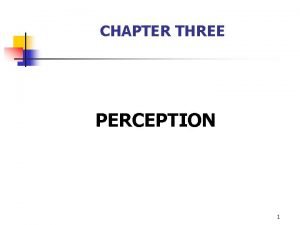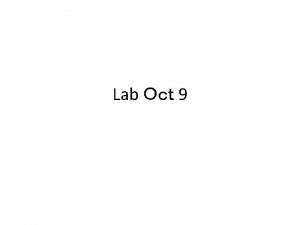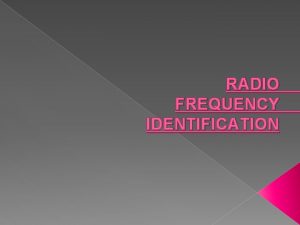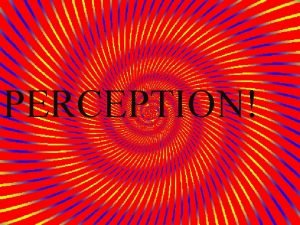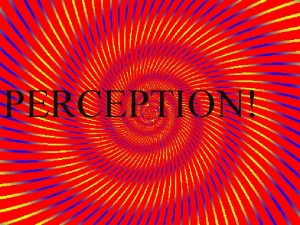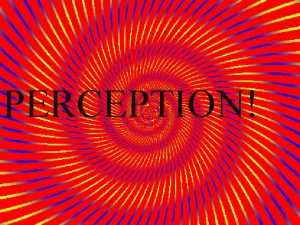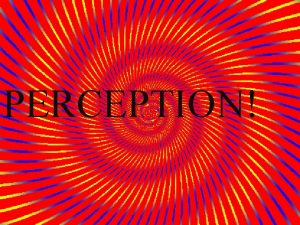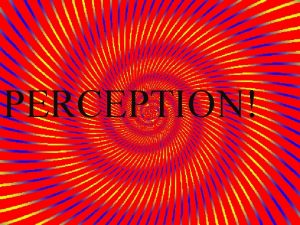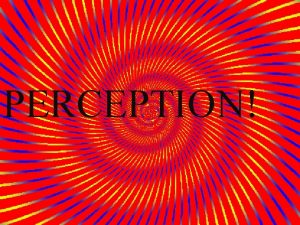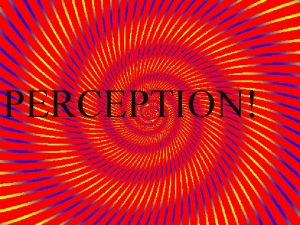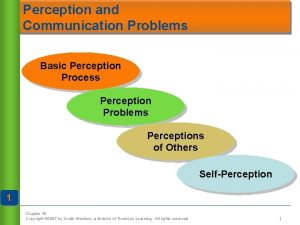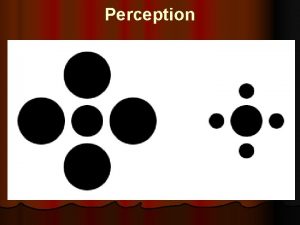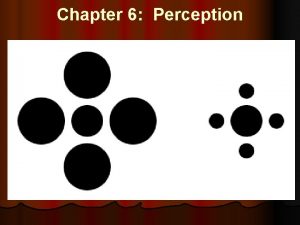Perception Perception Definition Perception The organization identification and

















- Slides: 17

Perception

Perception Definition • Perception – “The organization, identification, and interpretation of sensory information to understand the environment. ” http: //en. wikipedia. org/wiki/Perception

Gestalt Psychology Max Wertheimer: 1880 – 1943 Kurt Koffka: 1886 – 1941 Wolfgang Köhler: 1887 – 1967

Gestalt Psychology • Gestalt Psychology – “The whole is different than the sum of the parts. ” • Gestalt Laws of Perceptual Grouping include “similarity”, “proximity”, “good continuation”. http: //commons. wikimedia. org/wiki/File: Gestalt_proximity. svg http: //commons. wikimedia. org/wiki/File: Gestalt_similarity. svg http: //commons. wikimedia. org/wiki/File: Cross. Keys. png

http: //en. wikipedia. org/wiki/File: Gestalt_Principles_Composition. jpg Figure Ground / Reversible Figures

http: //en. wikipedia. org/wiki/File: Gestalt_Principles_Composition. jpg Illusory Figures

Perceptual Constancy • Perceptual Constancy – The perception of an object or quality as unchanging despite changes in the proximal stimulus. http: //en. wikipedia. org/wiki/File: Shape_constancy. gi f

https: //commons. wikimedia. org/wiki/File: Hot_air_balloon__color_constancy. jpg Perceptual Constancy

Top-Down vs Bottom-Up • Top-Down Process – – “Knowledge Driven” – Requires information beyond the stimulus • Bottom-Up – “Stimulus Driven” – Relies entirely on the neural response to stimulation

Top-Down vs Bottom-Up

Top-Down vs Bottom-Up https: //commons. wikimedia. org/wiki/File: Basketball. png https: //commons. wikimedia. org/wiki/File: Tennis_ball_01. jpg

Visual Neuroscience: What / Where Dorsal Pathway “Where” Ventral Pathway “What” http: //en. wikipedia. org/wiki/File: Ventral-dorsal_streams. svg

The Binding Problem - How is neural activity from different brain regions combined to give a coherent perceptual experience?

http: //en. wikipedia. org/wiki/File: Simulation. Neural. Oscillations. png The Binding Problem: Neural Synchrony

http: //en. wikipedia. org/wiki/File: Hermann_von_Helmholtz. jpg Unconscious Inference • Unconscious Inference – The phenomenon that occurs when one’s statistical knowledge of the environment alters the perception of proximal stimulation, without effort on the part of the perceiver. http: //en. wikipedia. org/wiki/File: Grey_square_optical_illusion. PNG http: //en. wikipedia. org/wiki/File: Ponzo_illusion. gif

Unconscious Inference • From Wiki – “The second card from the left seems to be a stronger shade of pink in the top picture. In fact they are the same color, but the brain changes its assumption about color due to the color cast of the surrounding photo. ” http: //en. wikipedia. org/wiki/Color-constancy http: //en. wikipedia. org/wiki/File: Colour. Illusion 2. jpg

 Central pocket whorl vs plain whorl
Central pocket whorl vs plain whorl Point by point vs block organization
Point by point vs block organization Process organization in computer organization
Process organization in computer organization Hình ảnh bộ gõ cơ thể búng tay
Hình ảnh bộ gõ cơ thể búng tay Bổ thể
Bổ thể Tỉ lệ cơ thể trẻ em
Tỉ lệ cơ thể trẻ em Voi kéo gỗ như thế nào
Voi kéo gỗ như thế nào Glasgow thang điểm
Glasgow thang điểm Chúa yêu trần thế alleluia
Chúa yêu trần thế alleluia Kể tên các môn thể thao
Kể tên các môn thể thao Thế nào là hệ số cao nhất
Thế nào là hệ số cao nhất Các châu lục và đại dương trên thế giới
Các châu lục và đại dương trên thế giới Công của trọng lực
Công của trọng lực Trời xanh đây là của chúng ta thể thơ
Trời xanh đây là của chúng ta thể thơ Mật thư anh em như thể tay chân
Mật thư anh em như thể tay chân Phép trừ bù
Phép trừ bù độ dài liên kết
độ dài liên kết


















